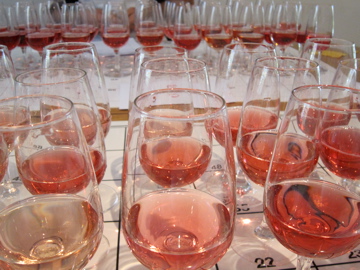Winning essay of the Lallemand Bursary 2011 for Master of Wine students.
The rosé landscape is looking particularly rosy. In the UK, for instance, rosé is now included in the basket of goods that measures inflation while in France, rosé has overtaken white wine as the nation’s favoured tipple. Consumers have been embracing a veritable palette of styles over the past five yeas, beyond the sweet, entry-level rosés that represented the category in the 1980’s. Producers are demonstrating increased focus on quality and innovation, making rosés that are setting the pace for a rosy future.
Rosés encompass the palest dry blush to the sweetest, strawberry pink coloured wines. While the category can include sparkling wines, still wines are the focus of this study. Rosé’s are produced from softly pressed red grapes or free-run (known as saignée in French, meaning bleeding) after a controlled maceration with skins that attains desired colour. Some basic rosés are created by blending red wine with white wine. Roughly 75% of the world’s rosés are produced in Europe – with France the leading producer. The USA makes approximately 20% and the rest of world, 5%.
In the 1980’s the most visible rosés were sweet, basic styles. Prominent examples included White Zinfandels, with sales skyrocketing in its home market, the USA, to 4.5m cases – 10% of the country’s total wine sales. Produced from zinfandel grapes and typically with 10% alcohol and 35-50g/l residual sweetness, the style was originally developed by Sutter Home the decade prior to supply market demand for white wines in the face of white grape shortages.
At the same time, global exports of Mateus Rosé from Portugal boomed. This slightly spritzy, sweet, low cost wine made from local Portuguese varieties including baga and touriga achieved sales in excess of 3.2m cases, 60% in Europe, and was followed closely by another Portuguese rosé brand, Lancers. By the 1990’s, however, consumer preferences shifted, notably to red wines, rendering these styles of rosés unfashionable.
Unfashionable, that was, until recently. In 2003 sales of rosé began rising, initially in the UK – the world’s leading wine importer. The heat wave of that year was a likely trigger for revitalised interest in rosé. Adam Lechmere, editor of decanter.com explained; “It was a long hot summer. People suddenly cottoned on to [rosé] as a very nice summer drink.” Sales of rosé grew by 65% in the UK from 2003-2007 and have been rising steadily since, reaching the £1bn last year – 12% of the UK’s total wine market.
The rosés that consumers are cottoning on to this time around are more varied in style compared with the 1980’s. One trend is towards dry, premium examples like classics of Europe. The UK based supermarket giant Sainsbury’s, for instance, steadily increased their range of rosés over the past five years and notably from 28 -40 last year alone. A spokesperson explained; “There is a definite move towards fresher, less syrupy styles. Italian varietals such as sangiovese are becoming very popular.” Consumer preferences, it seems, have evolved to embrace rosé’s diversity.
Exports of the dry, elegant rosés from Provence have also increased substantially over the past five years and by a staggering 50% last year alone. The greatest increase has been to the USA, with rosés commanding over USD8 per bottle (www.vinsdeprovence.com).
Plus a brand that’s risen to prominence recently is ‘Arrogant Frog’ from the Languedoc. Since Jean-Claude Mas launched the brand in 2004, growth has been phenomenal, making the company a leading French wine exporter. The Arrogant Frog Syrah Rosé, a dry, elegant style has been the best selling rosé in Australia for the past few years, for instance, outselling locally produced rosés. Other key export markets for the brand include Canada, Japan and the USA.
Also reminiscent is that sweet, low priced rosés have also regained momentum. Young drinkers and new consumers have been turning to such uncomplicated styles in recent years as an alternative to Alcopops (which are being taxed out of the market in some countries). In the Netherlands, where the majority of wine drinkers are young, rosé now represents 10% of all wine sales (www.dailymail.co.uk). These factors illustrate that there’s a proliferation of rosé choices available to fuel the varied and fickle tastes of the modern consumer.
The explosion of rosé styles is matched with an evolution in quality. Since the Appellation d’Origin Controllee (AOC) Provence was established in 1993, for instance, over 80% of the region’s rosés are now AOC classified. Plus, the region’s wine industry association; Conseil Interprofessionnel des Vins de Provence (CIVP) established the world’s first Rosé Wine Research & Experimentation Centre in 1999, further testament to producers’ commitment to evolving quality. And it’s significant globally as Provence makes around 8% of the world’s rosés.
Also in Europe and significant is that attempts in 2009 at changing the laws in the European Union (EU) that would have allowed blending of red and white wines to produce rosés outside champagne were thwarted. These are signs that the quality platform for rosés is being raised and the integrity of classic styles protected.
At the same time is a producer attempting to create a whole new benchmark for rosé. Striving to produce the world’s best rosé, Sacha Lichine, Bordeaux winemaker and son of the great vintner and writer Alexis Lichine, established Chateau D’Esclans in 2006 in the heart of Provence. Enlisting the help of Patrick Leon (esteemed winemaker of Château Mouton Rothschild and Opus One) the Garrus was born.
Garrus is made from old-vine grenache that’s been handled with meticulous care and is fermented and matured in individually temperature controlled 600L oak barrels – an innovation from Bordeaux. After only a few vintages, Garrus is commanding attention beyond the super yachts of the Côte D’Azur; the USA’s Wine Spectator Magazine, for example, awarded it 90/100 points in 2009. And, at around EUR80, it’s currently the world’s most expensive still wine rosé. The Garrus represents the evolution of a new iconic category for rosé.
It’s really not surprising that rosés have become so popular in recent years. As taste preferences have evolved, so too have rosés. Consumers have discovered and embraced rosés diversity and have left limiting preconceptions in the past. It’s because rosés truly offer a versatility no other category can contest; suiting red and white wine drinkers, matching with a vast array of foods or without, at any time of the day, on casual or formal occasions, for any wallet. Rosés will likely continue to tickle our palates various shades of pink for years to come.
AOC Provence Arrogant Frog Articles Charlie Melton Rose Virginia Domaine Ott Garrus Mateus Rose Provence Provence Rose Rosé Sacha Lichine saignee Sutter Home Three-step process Turkey Flat Rose White Zinfandel wine aroma wheel Wine evaluation wine tasting WSET


